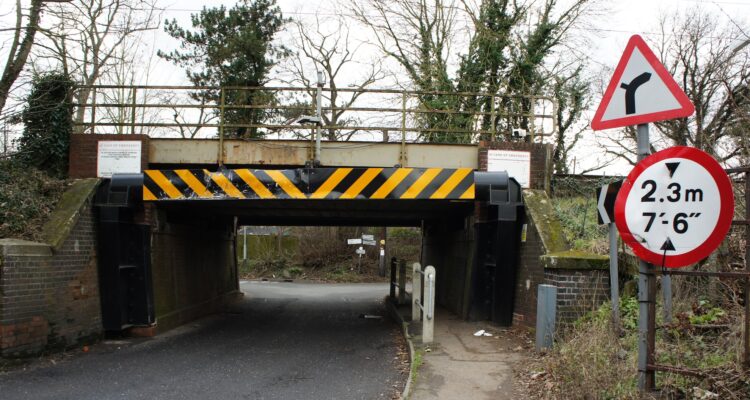Centrad, one of the UK’s leading commercial vehicle camera and telematics providers, has launched an innovative new Low Bridge Warning camera-based system to help operators mitigate the threat of bridge strikes.
The cutting-edge system, dubbed CenBridge, has been launched at a time where bridge strikes are still prevalent across the UK, with estimates suggesting that both large goods vehicles and buses hit five bridges every day, totalling around 1800 per year.
CenBridge has recently completed a successful trial with Bus Link, a Staffordshire based bus operator, where it demonstrated its ability to provide real-time alerts to drivers approaching low bridges.
According to Network Rail the aftermath of a bridge strike costs £13,000 per bridge – or £23 million over the course of a year. It is believed that over 90 percent of bridge strikes occur at railway bridges.
In recent years, both Network Rail and the Office of the Traffic Commissioner have taken a stricter stance on operators whose vehicles have been involved in bridge strikes by intensifying efforts to hold them accountable for failing to prevent such incidents.
Such is the severity of bridge strikes, and the seriousness of their potential consequences, that in 2018, Network Rail launched its ‘Wise Up, Size Up’ campaign, which was introduced to remind drivers to check their vehicle and plan their route to avoid low bridges prior to setting off.
Last year, the UK’s Senior Traffic Commissioner also reminded operators of large vehicles in an open letter of their duty to operate without posing unacceptable risks to road safety, highlighting the severe consequences and avoidable costs associated with bridge strikes.
Typically, bridge strikes occur due to drivers being unaware of their vehicle’s height, issues with reading the relevant signage or insufficient route planning and relying on satnavs which aren’t suitable for commercial vehicles. Commissioners actually stress that even having suitable satnav equipment isn’t a substitute for effective route planning.
If found responsible for a bridge strike, both operators and driver can face severe punishments ranging from fines and penalties to the suspension or revocation of licenses.
Centrad, which has extensive experience working in the commercial vehicle sector, has leveraged its expertise to develop a technology-led solution designed to address this critical issue head-on.
Through harnessing artificial intelligence with advanced geolocation technology, CenBridge has been expertly designed to proactively prevent bridge strikes by providing timely alerts to drivers when a low bridge is detected from a distance of 50 meters or more.
CenBridge’s innovative algorithm eliminates false positives and employs advanced deep learning specifically trained on a diverse range of UK low bridges, enabling it to detect in real-time low bridges without appropriate height limit signage, gantries, low bridges during harsh turns, even in low light conditions. The algorithm is continuously refined with remote updates, ensuring ever-improving accuracy and reliability.
CenBridge’s geolocation-based system also includes an extensive database of over 2,000 recorded low bridges across the UK and gives drivers both a real-time audio alerts, as well as an optional visual alerts, whenever their vehicle enters a geofenced zone.
Unlike traditional geolocation systems, which can be unreliable due to outdated databases or poor GPS signals, especially in urban environments, CenBridge guarantees enhanced performance by seamlessly integrating AI with precise geolocation data.
According to Geoff Cross, Managing Director of Centrad, he believes that while bridge strike numbers have come down in recent years, more needs to be done to quicken the pace of progress in reducing incidents, believing that the implementation of smarter technology by operators to prevent these costly and disruptive accidents is key to driving down incident figures.
Geoff commented: “The number one cause of bridge strikes is human error. Often traffic commissioners take the position that the vast majority of these incidents are avoidable, and attribute it directly to either negligence or insufficient training.
“Research indicates that 43 percent of drivers admit they do not measure their vehicle’s height before setting off, while 52 percent acknowledge neglecting to account for low bridges when planning their routes. Even with policies, procedures, and systems in place, along with extensive training provided by the operator, mistakes can still happen. Therefore, it’s clear that while continuing to raise awareness around bridge strikes and encourage regular training is important, another layer of protection is quite clearly needed.
“Unfortunately, training alone just isn’t enough, and with Network Rail now able to claim the cost of a bridge strike from operators, it’s an expensive, yet avoidable, accident waiting to happen.”
Geoff continued: “That’s where CenBridge comes in. By offering real-time alerts and precise location-based warnings, it gives drivers an additional safety net to avoid low bridges, essentially acting as a second set of eyes for drivers while they’re out on the road, preventing bridge strikes before they occur.
“As we cater to fleets of all sizes, we’ve made CenBridge available both as a standalone solution or as an additional option that can be integrated into our multi-camera systems, meaning operators don’t have to change their existing hardware.”






